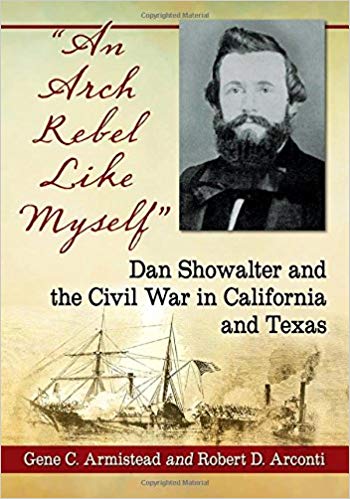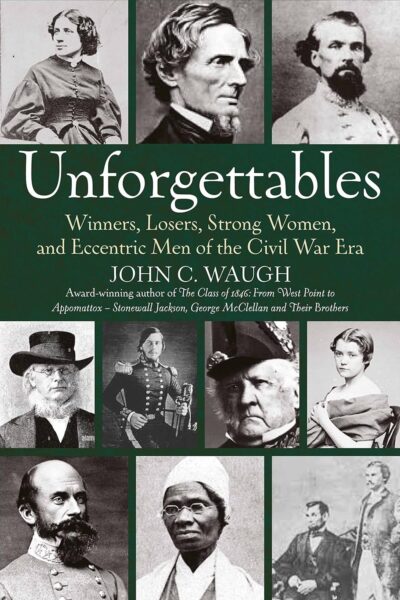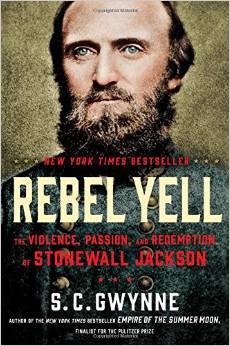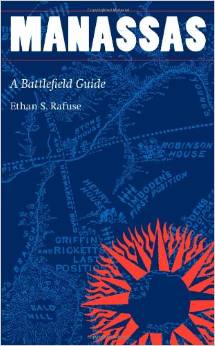“An Arch Rebel Like Myself”: Dan Showalter and the Civil War in California and Texas by Gene C. Armistead and Robert D. Arconti. McFarland & Company, Inc., 2018. Paper, IBSN: 978-1476674612. $39.95.
 Historians might know that Dan Showalter fought a duel in California in 1861 and killed a fellow member of the California Assembly. He also traveled with a group of rebel sympathizers in an abortive attempt to leave California. After a brief stint in prison at Fort Yuma, he set out for Texas, became Lieutenant Colonel of the 4th Arizona Cavalry, and rendered generally competent service in the Trans-Mississippi Theater of the U.S. Civil War. Aside from these points, however, most people know little about Showalter. This is particularly striking when one remembers, as Gene C. Armistead and Robert D. Arconti comment, that Showalter’s “was the name that became most associated in California with treason after the outbreak of the American Civil War” (3).
Historians might know that Dan Showalter fought a duel in California in 1861 and killed a fellow member of the California Assembly. He also traveled with a group of rebel sympathizers in an abortive attempt to leave California. After a brief stint in prison at Fort Yuma, he set out for Texas, became Lieutenant Colonel of the 4th Arizona Cavalry, and rendered generally competent service in the Trans-Mississippi Theater of the U.S. Civil War. Aside from these points, however, most people know little about Showalter. This is particularly striking when one remembers, as Gene C. Armistead and Robert D. Arconti comment, that Showalter’s “was the name that became most associated in California with treason after the outbreak of the American Civil War” (3).
Like many of his contemporaries, a fog of myths and legends obscures the details of his life. Studying Showalter presents something of a challenge, as he did not marry and have children, left few letters for posterity, and died young. The records of his rebel military service, in addition, are sparse. At many junctures, the authors admit that the best they can offer is conjecture. Nevertheless, they successfully utilize a variety of sources – newspapers, letters, and government documents, among others – to offer compelling analysis of one of the more notable residents of old California.
Showalter was born in Pennsylvania. The exact date of his birth is unknown, although it was likely 1831 or late 1830. Showalter accompanied his brother John to California to hunt for gold and the two reportedly brought back a “small fortune” (7). As an adult, Showalter “appears to have been very likeable and a tremendous conversationalist” (8). His mother’s untimely death and his father’s remarriage accelerated his desire to leave Pennsylvania. He returned to California in 1852 and settled in Horseshoe Bend in Mariposa County. In 1856, Democrats nominated Showalter for a seat in the California Assembly, and he won the race handily. The authors offer a comprehensive, if overly detailed, discussion of Showalter’s legislative service. Although he was not the “star” of the 1857 Assembly, he was nonetheless a “creditable member” (29). Showalter’s constituents seemed not to share this opinion, or perhaps they believed in rotation in office, because he failed in his reelection bid.
In 1860, Showalter again found himself nominated and elected to the Assembly. Because no party had a majority in the chamber, it took ten days and 109 ballots to elect a Speaker. Showalter, now part of the “Chivalry” or the Breckinridge faction of the Democratic Party, became his faction’s candidate for Speaker, but did not receive enough votes to win the position. As with their account of the 1857 Assembly, the authors go into great detail about the particulars of Showalter’s service. Their discussion would have benefitted from distinguishing between the important and relatively mundane aspects of legislative work. Interestingly, in an Assembly often riven by partisan strife, members from all factions voted for Showalter as Speaker pro tem, which Armistead and Arconti believe illustrates Showalter’s personal popularity. Showalter also delivered an incendiary speech on April 29, condemning Assemblyman John Conness’s bill to move up the elections for California Congressmen so California would be represented in the July 1861 Special Session of the 37th Congress. In this speech, Showalter proclaimed himself the “arch-traitor” because he denounced and deplored war (65). Showalter gained additional infamy for his duel with fellow Assemblyman Charles Piercy. Union newspapers remembered Piercy as a martyr to the Union and denounced the arch-traitor. Finally, Showalter may have waved the rebel flag in Sacramento on July 4, 1861, although the evidence is inconclusive.
Southern California was notoriously sympathetic to the Confederacy. The Knights of the Golden Circle were rumored to be legion in this region. Thus, it is no surprise that as he planned to leave California, Showalter staged his journey on friendly ground. Contrary to popular belief, Showalter did not lead a group of approximately twenty-five rebel sympathizers on their journey to Texas. However, as the most infamous member of the band, his name carried a certain cachet. U.S. soldiers captured the Showalter Party, as it was called, and imprisoned them for several months at Fort Yuma. Showalter was released in April 1862, after swearing an oath of allegiance to the U.S., although his oath proved utterly worthless. Showalter reached Texas several months after his release from Fort Yuma. He initially served as a member of General John Bankhead Magruder’s staff before becoming Lieutenant Colonel of the 4th Arizona Cavalry. The 4th Arizona served in Indian Territory before being transferred to Texas and the command of John S. “Rip” Ford. In a battle at Palmito Ranch in September 1864, Showalter faced a combined assault from U.S. and Mexican soldiers. Some of his contemporaries remembered Showalter turning in a disastrous, drunken performance; however, the authors contend that reports of his defeat were exaggerated and the charges of alcoholism unfair (they nonetheless concede Showalter may have imbibed due to the stress of battle). Showalter considered exile in Mexico preferable to remaining in the U.S. after the war. His death was as violent as his life. He apparently got drunk, fought with a bartender in Mazatlán, and died of tetanus caused by the wounds sustained in that particular battle.
“An Arch Rebel Like Myself” offers sound analysis of an enigmatic character. However, this book is sometimes too focused on Showalter to the exclusion of everything else. Case in point, the discussions of his service in the California State Assembly needed to distinguish between the important moments and quotidian elements of legislative life. In addition, Armistead and Arconti often overlook important people and events. U.S. Senator David Broderick, for example, receives a mention here and there, but the authors do not discuss the impact of his fatal duel with David S. Terry on California politics. Although this may seem like a small point, there are many other moments in this book where the authors do not provide sufficient context.
Furthermore, they assert that Showalter’s life and career “illustrate more completely than any others the secession crisis in 1861 California and its aftermath” (181). This claim is overstated. After all, Showalter was not even the most famous member of the “Chivalry” faction in California. Furthermore, California did not secede from the Union, nor did it form a Republic of the Pacific. The efforts of men like Cornelius Cole, Thomas Starr King, and Leland Stanford ensured California’s loyalty. Their stories are nowhere to be found in this book, which is problematic because the reader lacks crucial context about the world in which Showalter operated. In sum, this is a useful book for what it has to say about Showalter, but anyone seeking a full account of this period should pair it with other studies of California and Texas before, during, and after the U.S. Civil War.
Evan Rothera teaches courses in the Department of History at Sam Houston State University. He is at work on his first book.



